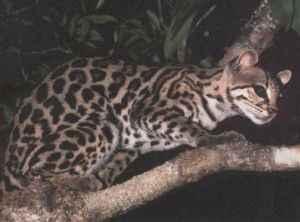|
Weight:
9-18 pounds
Head/Body: 26 inches
Tail: 16 inches
Subspecies: 11
The Margay, or Tree Ocelot, is well adapted for a true arboreal life. It is the only cat to possess the ability to rotate its hind legs 180�, enabling it to run head first down trees like squirrels. It can also hang from a branch by one hind foot. In their traversing at the canopies, even if they fall, they can come out unharmed. One can even stop its fall by grasping at the tree's limbs with its hind feet, then setting itself upright. Indeed, a most impressive act.
The Margay lives in the subtropical and the tropical forest regions of Central and South America. A typical individual weighs about 2.6 to 3.9 kgs. They are small, spotted cats, which bear a great deal of similarity with ocelots. The Margay's fur is thick but soft. Its feet are quite special; they are broad with movable toes and flexible ankles. This cat is dependent on the protection of tree canopy in the Central/South American territories in which they reside. It was observed that they can jump over 18 feet (vertical) and close to 30 feet horizontally.
Data regarding their reproduction has been gathered from Margays in captivity. A female Margay can breed in the first year, and the gestation period is from 74 to 84 days. Litter size is mostly one, although two is not impossible.
They consume a large variety of animals, and can catch either arboreal or ground mammals. Their diet consists of birds, reptiles, amphibians, fruits, etc. They are classified as basically carnivorous.
Margays are extremely rare and endangered throughout its range. In the past, thousands of individuals per year were harvested for their fur. Hunting pressure has decreased considerably following international protection, although some illegal harvesting still occurs locally. The virtually exclusive use of forested habitat may make L. wiedii more vulnerable than the ocelot to the negative effects of habitat destruction and fragmentation.
In the north of its range it is now almost extinct and it is listed in CITES Appendix I as an endangered species.

|



